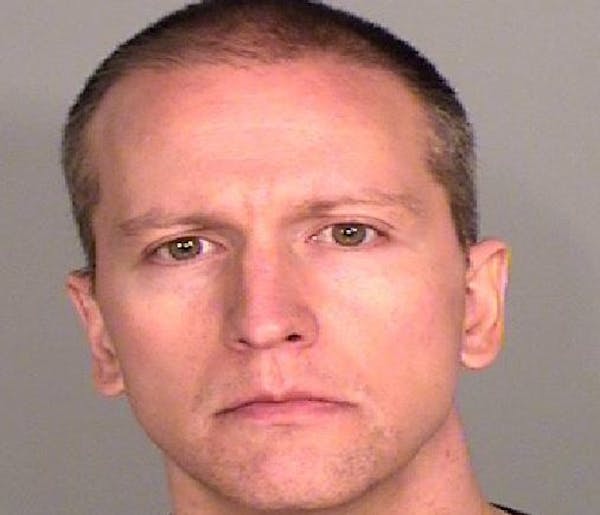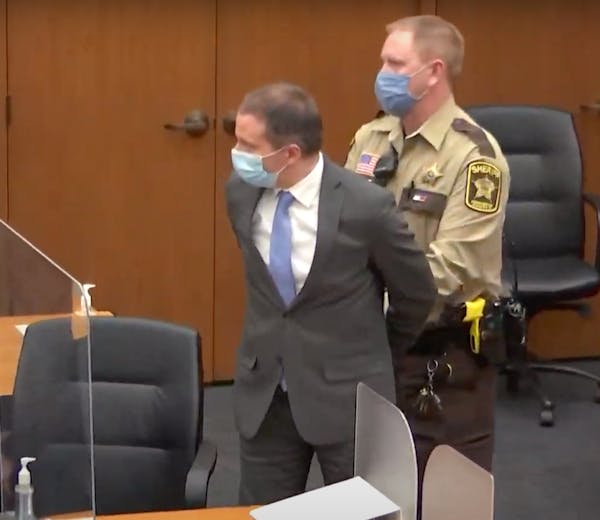A medical expert testified Thursday in the Derek Chauvin murder trial that George Floyd died from a lack of oxygen late last spring as the now-fired Minneapolis police officer knelt on the neck and then held that position for more than three minutes after Floyd drew his last breath.
Dr. Martin Tobin, a Chicago physician who has specialized in respiratory and critical care medicine for decades, said he has reviewed much of the evidence and concluded that "Floyd died from a low level of oxygen. This caused damage to his brain that we see, and it also caused a [pulseless electrical activity] arrhythmia that caused his heart to stop."
Cause of death has provided a sharp divide between the state and the defense. The prosecution is saying Floyd died from a lack of oxygen, while defense attorney Eric Nelson has argued that Floyd died of a cardiac arrest, illicit drug use and other factors.
The heavy dose of expert medical testimony filled the day until adjournment later than usual Thursday. The second week of testimony resumes Friday morning.
During the afternoon, jurors heard from a forensic toxicologist at NMS Labs, which tested Flood's blood for illicit drug use and found the presence of fentanyl and methamphetamine.
David Isenschmid said that while fentanyl was found in Floyd's blood, so was norfentanyl, which is metabolized fentanyl. Overdose victims who die rarely have norfentanyl in their blood, he said.
He testified that Floyd's ratio of fentanyl to norfentanyl was 1.96. This is compared to the average ratio of 9.05 nanograms per milliliter in postmortem cases and 3.2 ng/ml in driving under the influence cases of people who survive.
Floyd's level of methamphetamine was even lower compared to a sample of driving under the influence meth cases.
"Does this show Mr. Floyd was below the average and even below the median in DUI cases?" prosecutor Erin Eldridge asked. "Yes," he said.
The next witness, the police surgeon of the Louisville Police Department, reviewed videos from Floyd's arrest and other case records and also concluded that he died from a lack of oxygen and not from a fentanyl overdose. Much of what Dr. Bill Smock testified to supported Tobin's conclusions about Floyd's deteriorating condition and movements in his effort to keep breathing.
Smock, who regularly responds to crime scenes and emergency rooms, said that people who overdose on fentanyl become among other things sleepy, snore, have constricted pupils and their breathing rate falls.
Smock said Floyd was not snoring, had dilated pupils, and talking and saying "I can't breathe."
The doctor said "that is not a fentanyl overdose. That is someone begging to breathe."
Smock said Floyd also showed no signs at the scene of a diagnosis called excitable delirium, which someone afflicted grows extremely hot, is moving about rapidly and exhibits superhuman strength. Again, according to Smock, Floyd showed none of the many symptoms of this malady, which one of the officers raised at Floyd's arrest.
He also addressed the need for CPR, "way before it was. As soon as Mr. Floyd was unconscious, he should have been rolled over. ... When they can't find a pulse, CPR should have been started."
Many of Nelson's questions for Smock centered on various health conditions that Floyd was known to have, an area the defense is asserting had a role in his death.
Smock agreed that Floyd had cardiovascular disease, a severe blockage in an artery, high blood pressure, as well as fentanyl and methamphetamine in his system. He also agreed that struggling with police can put stress on the heart.
As he did earlier this week, Nelson raised the prospect of Floyd being deceptive early on when he was saying he couldn't breathe when "no one was on his back" while in the squad car. Smock agreed with Nelson's account of what Floyd said and when.
Jurors paid close attention to Dr. Tobin's testimony from start to finish, watching every video, chart or illustration, listening closely to his testimony, and taking notes at specific points. Tobin spoke directly to the jury most of the time, loosening his tie and unbuttoning his top button to demonstrate parts of the neck. In some cases, jurors followed his lead, but Judge Peter Cahill told them they didn't have to do so.
Using "precise science," Tobin said Floyd lapsed into unconsciousness shortly before 8:25 p.m. on May 25 as his oxygen levels plummeted.
Floyd stopped breathing 23 seconds later and "didn't have an ounce of oxygen in his body" less than a minute after losing consciousness, Tobin said. He noted the moment Floyd died when shown the bystander video of his final moments.
"At the beginning you can see he's conscious, you can see slight flickering and then it disappears, so one second he's alive and one second he's no longer," Tobin said. " ... That's the moment the life goes out of his body."
After Floyd's breathing ceased, the doctor said that Chauvin's "knee remained on the neck for another 3 minutes and 27 seconds."
Virtually all of the jurors took notes after that calculation.
Tobin also noted that one video showed office J. Alexander Kueng checking Floyd for a pulse and saying that he didn't find one. From that moment, the doctor said he determined that Chauvin's knee remained on Floyd for another 2 minutes and 44 seconds.
The doctor also challenged the defense contention that the powerful opioid fentanyl was a factor in Floyd's death. Analyzing Floyd's breathing rate by viewing one of the officer's body-camera video, Tobin found the rate to be in the normal range. Fentanyl, he said, sharply reduces a person's breathing rate.
Therefore, he said, "Basically, it's telling you fentanyl is not on board, it is not having an effect on his respiratory centers."
Tobin, who is based at Hines VA hospital in Chicago and Loyola University, added, "The cause of the low level of oxygen was shallow breathing; small breaths ... that weren't able to carry the air through his lungs down to the essential areas of the lungs that get oxygen into the blood and get rid of the carbon dioxide."
Tobin listed the factors leading to Floyd being unable to take in oxygen, among them, "He is turned prone on the street, that he has the handcuffs in place combined with the street, and that he has a knee on his neck, and he has a knee in his back and side."
Under cross examination, defense attorney Eric Nelson's questioning prompted Tobin to acknowledge that he based some of his scientific conclusions on a number of assumptions, given that no one was at the scene to take various measurements including Chauvin's net weight with his gear and Floyd's breathing patterns.
Tobin countered that his calculations "are based on direct evidence, they are based on research [and] very few assumptions."
"You would agree that the amount of time you've spent looking at videos analyzing perspectives is far greater than the length of this incident?" Nelson asked.
"Yes," Tobin said.
"Times a thousand?"
"It's substantially greater than the incident," Tobin acknowledged.
Nelson then listed various areas, and Tobin agreed, where he needed to make assumptions about Chauvin's weight and how much it shifted from left to right and considered Floyd to be a healthy subject despite evidence of heart disease and other health problems.
Nelson asked Tobin about the 70 to 90% blockage found in Floyd's coronary arteries and whether that may have been a contributing factor.
Tobin said that if that were a contributor, Floyd would have complained of chest pain and had a rapid respiratory rate. Evidence has so far revealed neither occurring.
During a second round of questioning by prosecutor Jerry Blackwell, Tobin said Floyd's health challenges would have no adverse effect "whatsoever" on his ability to breathe.
Nelson moments earlier also pointed out that Floyd had no bruising on the neck, despite Chauvin's actions. Blackwell asked Tobin why that would be, and the doctor said the contact was static and not delivered in something akin to a punch.
"When I go to church, I sit on a hard bench," Tobin said. "I don't get bruising on my bottom."
Blackwell also seized on Nelson getting Tobin to agree that fentanyl can be deadly. Tobin told Blackwell that a fentanyl user who dies first lapses into a coma.
"Did Mr. Floyd ever go into a coma?" The doctor, seemingly amused that he was being asked the question, replied, "no."
Unlike many experts called to testify in cases, Tobin said he is not being paid. He said he has testified in dozens of malpractice cases, but this is his first as a witness in a criminal proceeding. He said the prosecution came to him about testifying, and he agreed because "I thought I might have some knowledge to explain how Mr. Floyd died."
Using a composite video during direct testimony, Tobin showed jurors how Floyd was positioned with the officers on top of him and how it contributed to his inability to take sufficient breaths. He said Chauvin and officer Kueng manipulated Floyd's handcuffs by "pushing them into his back and pushing them high," which further hindered his ability to breathe.
"It's like the left side is in a vise, it's being pushed in from the street at the bottom and the way the handcuffs are manipulated … totally interferes with central features of how we breathe," he said.
Tobin said Floyd also used his left shoulder in attempt to create chest space to draw a breath, but "the shoulder is a very ineffective way of breathing."
"Basically, on the left side of his chest," Tobin continued, "it's as if a surgeon almost went in and removed the lung ... and left him totally reliant on his right side," the doctor said.
With a photo shown in court of Floyd's knuckles bracing in order to get air, Tobin said, "To most people, this doesn't look terribly significant, but to a physiologist this is extraordinarily significant, because this shows the has used up all his resources and showed he is trying to breathe with his fingers and knuckles."
With his left lung rendered useless, the doctor said that Floyd "is totally dependent on getting air into the right side. He's using his fingers and knuckles against [a squad tire and the street] to try and crank up his chest. This is his only way to get air into the right lung."
The knee on Floyd's neck also restricted "air getting into the passageway," according to the doctor, who said it left him trying to breathe through a space narrower than a small straw. He called that "enormously difficult, and we know that from physics."
Tobin then turned his attention to the amount of weight being pressed onto Floyd's neck. He noted that Chauvin kept his upper body erect while having his left knee on Floyd's neck while at times lifting his left toe.
"We're talking half of his body weight and half of his gear [weight], and all of that is coming down," the doctor said. A graphic accompanying this part of his testimony read that lifting the toe increased the weight pressed on Floyd's neck from about 86 pounds to more than 91.
Tobin also focused on a specific passage of time of Chauvin having his knee on Floyd's neck. He said that various video from the scene indicated Floyd suffered brain injury about 5 minutes into his restraint on the street. This is when Floyd "kicked out his leg in an extension form" and that response is when "we see he suffered brain injury from a low level of oxygen."
Along with the left knee on the neck hindering Floyd's ability to breathe, Tobin said Chauvin's right knee on the back made things more difficult while "the street is playing a huge part … and totally preventing every action on the front."
With both knees on the body, "you are now seeing a 43% reduction" in Floyd's lung capacity, he said.
Also Thursday, the prosecution confirmed that it intends to soon call as a witness Dr. Andrew Baker, the Hennepin County medical examiner who performed the only autopsy on Floyd soon after he died.
Baker ruled Floyd's cause of death as cardiac arrest, namely "cardiopulmonary arrest complicating law enforcement subdual, restraint, and neck compression." He also listed hardening and thickening of the artery walls, heart disease and drug use as "other significant conditions." Fentanyl and methamphetamine were also found in Floyd's system.
The prosecution, however, said in its opening statement at the start of last week that it would prove Floyd died of asphyxia, or lack of oxygen, while Chauvin knelt on his neck for more than nine minutes.
Defense attorney Nelson has argued that Floyd died of a cardiac arrest resulting from illicit drug use and ongoing health problems, including heart disease and high blood pressure.
Chauvin is on trial for second-degree murder, third-degree murder and manslaughter. The three other fired officers — Kueng, Thomas Lane and Tou Thao — are to go on trial in August on charges of aiding and abetting him.

Fired Mpls. teacher accuses management of 'cancerous rot'

Jill Biden rallies women, teachers for the Biden-Harris ticket in Bloomington speeches
Neighbors, city officials at odds over Rochester lake dam

Souhan: This is KAT's chance to prove Flip Saunders was right



